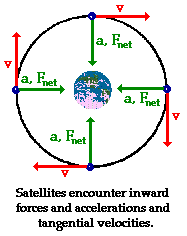A satellite moves around the earth in a circular orbit with constant speed.Explain is the motion uniform or accelerated ?
1 Answer
Uniform circular motion, but the satellite is accelerated towards the centre of the earth.
Explanation:
There are a few concepts with regards to a satellite orbiting the earth.
- The orbit is actually elliptical, but it is treated as circular for easier calculations.
- The satellite is orbiting with constant speed.
- The satellite's velocity is always changing.
- The satellite is accelerating, because there is a net force acting on it.
- The force of gravity on the satellite is the centripetal force.
Key concept:
Speed - is a scalar quantity, which only has magnitude.
Velocity - is a vector quantity, it possesses both magnitude and direction.
A geostationary satellite orbits the earth with a velocity of 3.07km/s.
So, the satellite orbits the earth with a constant speed of 3.07km/s because the magnitude of its speed is constant.
However, its direction is constantly changing, as seen in the diagram below.
At the west side of its orbit, the direction of the satellite is upwards. At the north of its orbit, the direction changes to rightward.
Therefore, the velocity of the satellite is always changing.
(The direction of velocity is tangential to its circular path.)

According to Newton's Second Law, the satellite is accelerating because it experiences a net force acting on it, and also because its velocity is changing.
The direction of the satellite's acceleration is not tangential to the circular motion, but rather perpendicular to its velocity/towards the centre of the earth.
This acceleration is a result of earth's gravitational force on the satellite. The acceleration is also known as centripetal acceleration.
It is also useful to know that the force of gravity provides the necessary centripetal force for a stable orbit.
Hence, the astronauts experience weightlessness because there are no reaction forces when they touch the objects around them.
